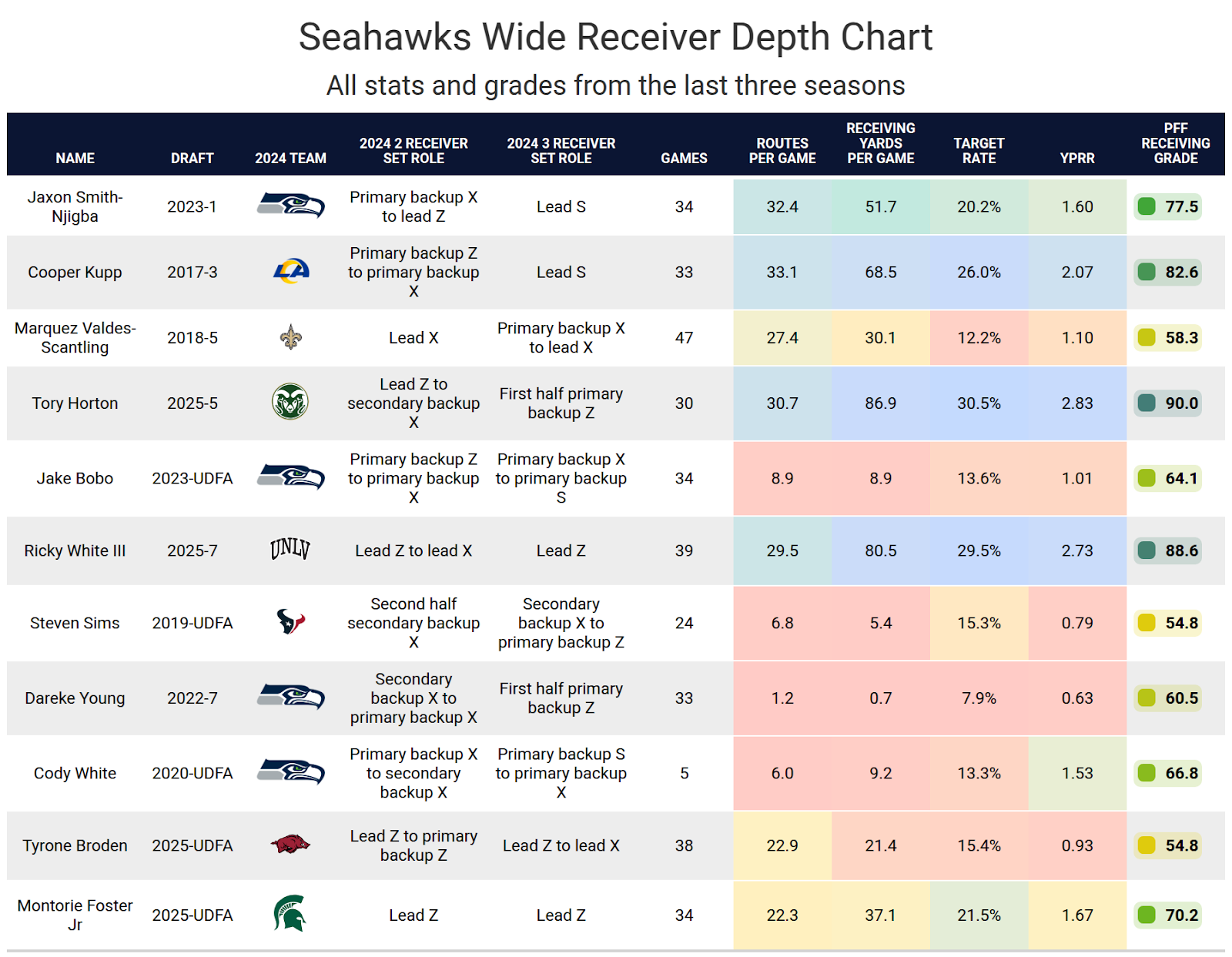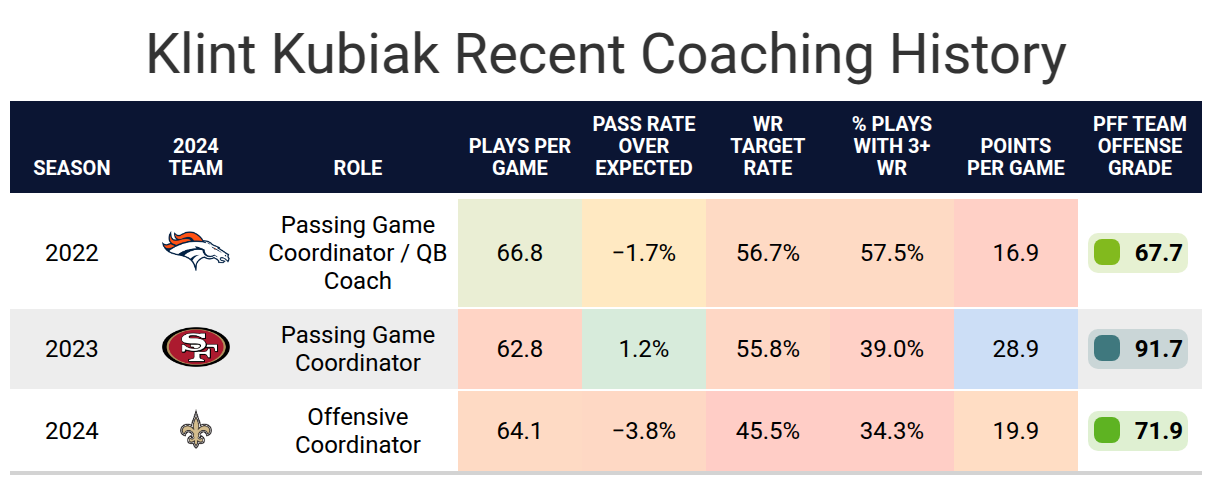- Jaxon Smith-Njigba shined in late 2024: Smith-Njigba scored the second-most fantasy points for a wide receiver over an eight-game stretch starting in November.
- The Seattle Seahawks will look far different on offense: The team has a new offensive coordinator, a new quarterback and three new wide receivers to join Smith-Njigba at the top of the depth chart. The changes might not be good news for his fantasy production.
- Subscribe to PFF+: Get access to player grades, PFF Premium Stats, fantasy football rankings, all of the PFF fantasy draft research tools and more!
Estimated Reading Time: 7 minutes

PFF’s Fantasy Football Player Profile series delivers the most in-depth fantasy football analysis available for the 2025 season.
Using PFF’s exclusive data, we evaluate player performance, competition for touches and how teammates and coaching staffs will impact each player's fantasy football outlook.
Last updated: 7:15 a.m. Monday, May 19
Player Performance
The Seahawks made Smith-Njigba the 20th overall pick in the 2023 NFL Draft, joining entrenched starters D.K. Metcalf and Tyler Lockett as the third wide receiver in three-receiver sets. He averaged 64% of offensive snaps during his rookie season, ranging from 44% to 82%. Naturally, he played more in losses, where he was typically in the 67%-75% range. In wins, he was typically in the 52%-66% range. Smith-Njigba caught a pass in every game but never gained more than 63 yards in an outing.
Smith-Njigba’s role changed in his second season, as he played more often in two-wide receiver sets. He averaged 86% of snaps in 2024, including playing at least 94% of snaps in four of the last five games. He showed his potential in Week 2 with 12 receptions for 117 yards against the New England Patriots. His stat lines during the rest of September and October were reminiscent of his rookie season.
He then posted the best game of his career against the Los Angeles Rams, with seven receptions for 180 yards and two touchdowns. This time, he built on that momentum with six consecutive games of notching at least 70 receiving yards. From Weeks 9-16, he averaged 21.8 PPR points per game, which ranked second among wide receivers. He disappeared in the last two games of the season during two victories, catching a combined seven passes for 41 yards.
Smith-Njigba's 36.8 routes and 5.8 receptions per game both ranked 10th among all wide receivers over the 2024 season.


Projected Role
Smith-Njigba has primarily been a slot receiver. He played in 6.4% of two-receiver sets as a rookie. That increased to 50.3% over the first 13 weeks of 2024 and 78.9% over the last five weeks of the season. When Smith-Njigba was on the field, he was thrown to a lot more in 2024, even though his first-read target rate increased only slightly. His target share specifically skyrocketed in the red zone.
Seattle completely changed its wide receiver room, moving on from long-term starters D.K. Metcalf and Tyler Lockett this offseason. In their place, Seattle added veterans Cooper Kupp and Marquez Valdes-Scantling and fifth-round pick Tory Horton. Kupp is Smith-Njigba’s primary competition for targets. He was a great receiver earlier in his career, but his PFF receiving grade has dropped to 71.1 and 72.3 over the past two seasons, respectively. Talent-wise, Smith-Njigba should be the clear top option in the Seahawks' offense.
His fit with Kupp is interesting because both Smith-Njigba and Kupp have primarily been slot receivers in the NFL.


Impact of Teammates
New Seahawks offensive coordinator Klint Kubiak has bounced around with four teams in the past four seasons, but there have been a few trends, including using three-wide receiver sets at a low rate. The New Orleans Saints last season were an extreme example after injuries to Chris Olave and Rashid Shaheed, and the San Francisco 49ers have generally been extreme throughout Kyle Shanahan’s time with the team. However, the trend has still been true in Kubiak's other landing spots.
This means Smith-Njigba and Kupp will play out wide more than usual. If Seattle uses three-wide receiver sets only 50% of the time and the two split the slot snaps evenly, both could line up in the slot for roughly 25% of their snaps. Smith-Njigba has a better yards per route run lined up out wide compared to the slot, so that might not be a terrible move for his fantasy value.
Kubiak’s offenses haven’t had a clear slot receiver in the past, with a lot of players typically sharing the role. Jerry Jeudy was the only wide receiver to surpass 500 yards out of the slot (519) in a Kubiak offense over the past four seasons, while Smith-Njigba racked up 993 of his yards from the slot last season. Either Kubiak’s offense will need to adapt to Smith-Njigba, or Smith-Njigba will need to adapt to the offense.
One concern is that Kubiak’s offenses have relied a lot on the run game, and that will likely be the case for the Seahawks. Kubiak may want the best run-blocking wide receivers on the field for some early-down plays. Smith-Njigba is the smallest of the Seahawks' top wide receivers, and his 42.2 PFF run-blocking grade is the 11th lowest among 80 wide receivers with at least 1,000 snaps in the past two seasons. Kupp ranks 12th at 60.3, while Valdes-Scantling places 33rd at 54.6. Rookie Tory Horton is also noted to be a willing blocker. Smith-Njigba might be back to primarily playing in three-wide receiver sets in this offense in 2025.
Kubiak’s offenses have also featured low target rates to wide receivers. Seattle has a strong running back room and just invested a second-round pick in tight end Elijah Arroyo. The team's offenses in recent years have been run-heavy, but the wide receivers were always the focal point of the passing game. The wide receivers who have produced in Kubiak’s offenses have generally had an average depth of target over 12 yards — notably higher than Smith-Njigba's and Kupp's figures last season. One exception was Adam Thielen, who was WR28 in 2021. The other was Deebo Samuel, who was WR15 in 2023 (but WR34 when ignoring his rushing production).
The Seahawks added quarterback Sam Darnold in free agency and drafted rookie signal-caller Jalen Milroe. Both throw deep at high rates, which, if anything, is good news for Valdes-Scantling. Working in Smith-Njigba's favor is that Darnold doesn’t throw to his first read at a high rate. Smith-Njigba has strong separation skills and could be a frequent target when Darnold is going through his progressions.


Bottom Line
Smith-Njigba showed promise with Seattle last season, but volume is king in fantasy football. His production is built on volume, and it’s fair to question how much volume he will see in 2025. Past Klint Kubiak wide receivers haven’t produced the same way Smith-Njigba did last season.

Footnotes
- Statistics in tables and charts were chosen based on their ability to predict future fantasy performance on a per-game or per-opportunity basis or to describe the player relative to others at the same position.
- “Opportunities” are defined as passing dropbacks, rushing attempts and routes run as a receiver.
- Numbers are provided either by season or based on the past three years. For rookies, only college statistics are included. For non-rookies, only NFL statistics are considered, regardless of whether they played in college within the previous three years.
- As college competition is easier than NFL competition, most rookies are likely to see a decline from their historical numbers.
- Only FBS data is considered for college players and comparisons.
- Kneel-downs are removed from rushing data to provide cleaner quarterback rushing rate statistics.
- The table colors in this article range from blue (indicating good/high) to red (indicating bad/low).
- All percentiles and color codings compare the given player to others with a high sample of opportunities. Generally, the cutoff is one-third of the possible opportunities in the sample. If a player does not meet the threshold, they are still included in the comparison, though their results may appear better or worse than expected due to the smaller, less predictive sample size.
- Information on utilization classifications and their importance can be found here for running backs, wide receivers and tight ends.



 © 2025 PFF - all rights reserved.
© 2025 PFF - all rights reserved.